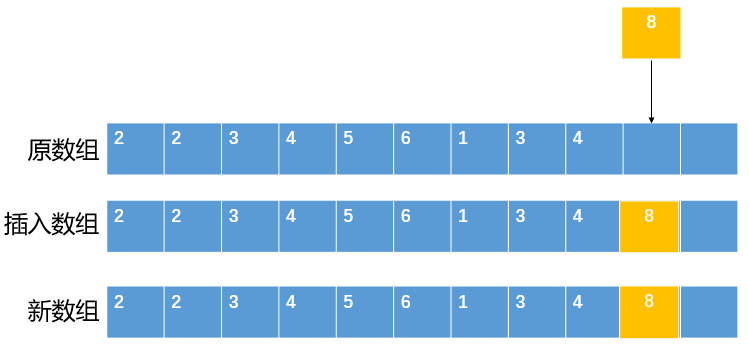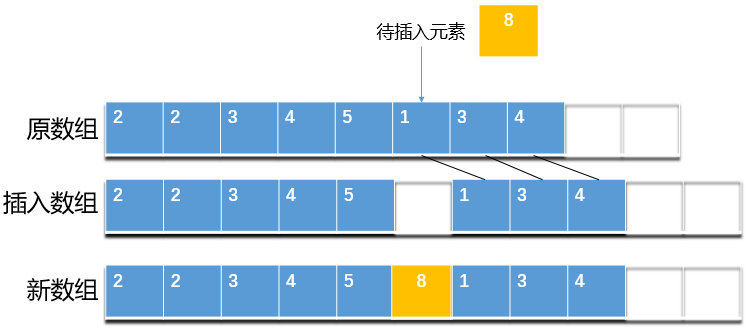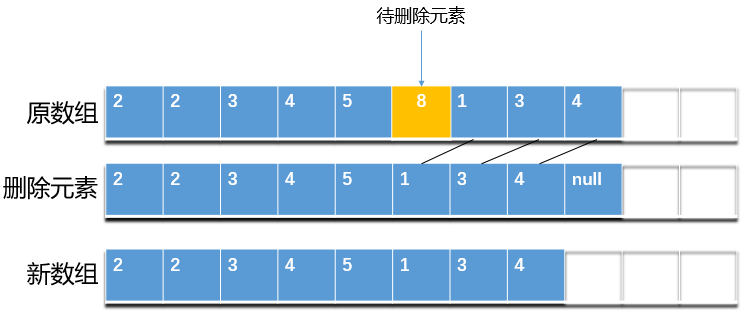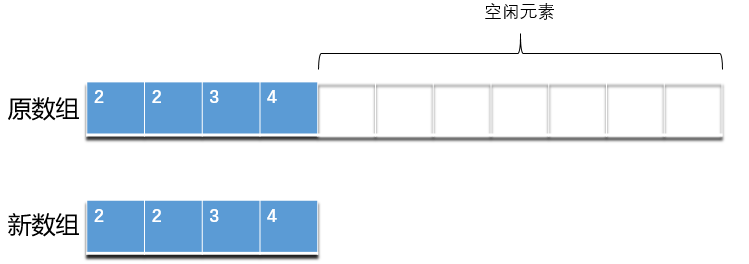ArrayList源码分析-jdk11 (18.9)
1.概述
ArrayList 是一种变长的集合类,基于定长数组实现。ArrayList 允许空值和重复元素,当往 ArrayList 中添加的元素数量大于其底层数组容量时,其会通过扩容机制重新生成一个更大的数组。另外,由于 ArrayList 底层基于数组实现,所以其可以保证在 O(1) 复杂度下完成随机查找操作。其他方面,ArrayList 是非线程安全类,并发环境下,多个线程同时操作 ArrayList,会引发不可预知的错误。
ArrayList 是大家最为常用的集合类,作为一个变长集合类,其核心是扩容机制。所以只要知道它是怎么扩容的,以及基本的操作是怎样实现就够了。本文后续内容将围绕jdk11 (18.9)中ArrayList的源码展开叙述。
2.源码分析
2.1参数
1、ArrayList默认容量为10DEFAULT_CAPACITY注释
2、ArrayList并不是在初始化的时候就创建了 DEFAULT_CAPACITY=10 的数组。而是在往里边 add 第一个数据的时候会扩容到 10 elementData注释
private static final long serialVersionUID = 8683452581122892189L;
/**
* 默认初始化容量
*/
private static final int DEFAULT_CAPACITY = 10;
/**
* 用于空实例的共享空数组实例。
*/
private static final Object[] EMPTY_ELEMENTDATA = {};
/**
* Shared empty array instance used for default sized empty instances. We
* distinguish this from EMPTY_ELEMENTDATA to know how much to inflate when
* first element is added.
* 用于默认大小的空实例的共享空数组实例。我们将其与EMPTY_ELEMENTDATA分开来,以了解添加第一个元素时要膨胀多少。
*/
private static final Object[] DEFAULTCAPACITY_EMPTY_ELEMENTDATA = {};
/**
* The array buffer into which the elements of the ArrayList are stored.
* The capacity of the ArrayList is the length of this array buffer. Any
* empty ArrayList with elementData == DEFAULTCAPACITY_EMPTY_ELEMENTDATA
* will be expanded to DEFAULT_CAPACITY when the first element is added.
存储ArrayList元素的数组缓冲区,ArrayList的容量是这个数组缓冲区的长度。当第一个元素被添加的时候,elementData == DEFAULTCAPACITY_EMPTY_ELEMENTDATA 将被扩展成 DEFAULT_CAPACITY
*/
transient Object[] elementData; // non-private to simplify nested class access
/**
* The size of the ArrayList (the number of elements it contains).
* 数组大小
* @serial
*/
private int size;
2.2 构造方法
ArrayList 有三个构造方法,无参构造方法、构造空的具有特定初始容量值方法、构造一个包含指定集合元素的列表,按照集合的迭代器返回它们的顺序。
2.2.1 无参构造方法
注意下图中的注释Constructs an empty list with an initial capacity of ten 调用无参构造方法,默认构造一个容量为10的空list.
/**
* Constructs an empty list with an initial capacity of ten.
*/
public ArrayList() {
this.elementData = DEFAULTCAPACITY_EMPTY_ELEMENTDATA;
}
2.2.2 构造空的具有特定初始容量值方法
1、在知道将会向 ArrayList 插入多少元素的情况下 2、在有大量数据写入 时;一定要初始化指定长度。
/**
* Constructs an empty list with the specified initial capacity.
*
* @param initialCapacity the initial capacity of the list
* @throws IllegalArgumentException if the specified initial capacity
* is negative
*/
public ArrayList(int initialCapacity) {
if (initialCapacity > 0) {
this.elementData = new Object[initialCapacity];
} else if (initialCapacity == 0) {
this.elementData = EMPTY_ELEMENTDATA;
} else {
throw new IllegalArgumentException("Illegal Capacity: "+
initialCapacity);
}
}
2.2.3构造一个包含指定集合元素的列表,按照集合的迭代器返回它们的顺序
/**
* Constructs a list containing the elements of the specified
* collection, in the order they are returned by the collection's
* iterator.
构造一个包含指定集合元素的列表,按照集合的迭代器返回它们的顺序
* @param c the collection whose elements are to be placed into this list
* @throws NullPointerException if the specified collection is null
*/
public ArrayList(Collection<? extends E> c) {
elementData = c.toArray();
if ((size = elementData.length) != 0) {
// defend against c.toArray (incorrectly) not returning Object[]
//防御c.toArray(错误地)不返回Object[]
// (see e.g. https://bugs.openjdk.java.net/browse/JDK-6260652)
// jdk bug(Arrays内部实现的ArrayList的toArray()方法的行为与规范不一致) 15年修复;
if (elementData.getClass() != Object[].class)
elementData = Arrays.copyOf(elementData, size, Object[].class);
} else {
// replace with empty array.
this.elementData = EMPTY_ELEMENTDATA;
}
}
JDK-6260652 (see e.g. https://bugs.openjdk.java.net/browse/JDK-6260652)
简单来说就是,就是下图代码会产生的情况。
Object[] objects = new String[]{"string"};
objects[0] = 1;
/**
Exception in thread "main" java.lang.ArrayStoreException: java.lang.Integer
*/
产生原因
public Object[] toArray() {
return a.clone();
}
Arrays内部实现的ArrayList的toArray()方法的行为与规范不一致。根据JLS规范String[]的clone方法返回的也是String[]类型,所以toArray()方法返回的真实类型是String[],所以个toArray()[0]赋值时可能会导致类型不匹配的错误
jdk11中的Arrays内部实现的ArrayList的toArray()方法。所以调用copyOf()返回值类型为Object[]
public Object[] toArray() {
return Arrays.copyOf(a, a.length, Object[].class);
}
2.3常见方法
2.3.1插入
对于数组(线性表)结构,插入操作分为两种情况。一种是在元素序列尾部插入,另一种是在元素序列其他位置插入。ArrayList 的源码里也体现了这两种插入情况,如下:
/**
* This helper method split out from add(E) to keep method
* bytecode size under 35 (the -XX:MaxInlineSize default value),
* which helps when add(E) is called in a C1-compiled loop.
(这个辅助方法是从add(E)方法分离而来的,为了保持方法字节码低于35,这将有助于add(E)方法调用C1编译循环)
*/
private void add(E e, Object[] elementData, int s) {
if (s == elementData.length)
elementData = grow();
/**
private Object[] grow() {
return grow(size + 1);
}**/
//将新元素插入序列尾部
elementData[s] = e;
size = s + 1;
}
/**
* Inserts the specified element at the specified position in this
* list. Shifts the element currently at that position (if any) and
* any subsequent elements to the right (adds one to their indices).
在此列表的指定位置插入指定的元素。将当前位于该位置的元素(如果有)和任何后续元素向右移动(在其索引中添加一个元素)
* @param index index at which the specified element is to be inserted
* @param element element to be inserted
* @throws IndexOutOfBoundsException {@inheritDoc}
*/
public void add(int index, E element) {
rangeCheckForAdd(index);
modCount++;
final int s;
Object[] elementData;
if ((s = size) == (elementData = this.elementData).length)
elementData = grow();
// 2. 将 index 及其之后的所有元素都向后移一位
System.arraycopy(elementData, index,
elementData, index + 1,
s - index);
// 3. 将新元素插入至 index 处
elementData[index] = element;
size = s + 1;
}
2.3.1.1元素序列尾部插入
- 检测数组是否有足够的空间插入
- 将新元素插入至序列尾部
如下图:

2.3.1.2元素序列指定位置(假设该位置合理)插入
- 检测数组是否有足够的空间
- 将 index 及其之后的所有元素向后移一位
- 将新元素插入至 index 处
如下图:

从上图可以看出,将新元素插入至序列指定位置,需要先将该位置及其之后的元素都向后移动一位,为新元素腾出位置。这个操作的时间复杂度为O(N),频繁移动元素可能会导致效率问题,特别是集合中元素数量较多时。在日常开发中,若非所需,我们应当尽量避免在大集合中调用第二个插入方法。
2.3.2 ArrayList 的扩容机制
对于变长数据结构,当结构中没有空余空间可供使用时,就需要进行扩容。在 ArrayList 中,当空间用完,其会按照原数组空间的1.5倍进行扩容。相关源码如下:
/** 扩容的入口方法 */
/**
* Increases the capacity of this {@code ArrayList} instance, if
* necessary, to ensure that it can hold at least the number of elements
* specified by the minimum capacity argument.
*增加{@code ArrayList}实例的容量,如果必需的,以确保它至少可以容纳minimum capacity参数指定的元素数
* @param minCapacity the desired minimum capacity
*/
public void ensureCapacity(int minCapacity) {
if (minCapacity > elementData.length
&& !(elementData == DEFAULTCAPACITY_EMPTY_ELEMENTDATA
&& minCapacity <= DEFAULT_CAPACITY)) {
modCount++;
grow(minCapacity);
}
}
/** 扩容的核心方法 */
/**
* Returns a capacity at least as large as the given minimum capacity.
* Returns the current capacity increased by 50% if that suffices.
* Will not return a capacity greater than MAX_ARRAY_SIZE unless
* the given minimum capacity is greater than MAX_ARRAY_SIZE.
返回至少等于给定最小值的容量容量。返回当前容量增加50%,如果够了。不会返回大于MAX_ARRAY_SIZE的容量,除非给定的最小容量大于MAX_ARRAY_SIZE
* @param minCapacity the desired minimum capacity
* @throws OutOfMemoryError if minCapacity is less than zero
*/
private int newCapacity(int minCapacity) {
// overflow-conscious code
int oldCapacity = elementData.length;
int newCapacity = oldCapacity + (oldCapacity >> 1); //旧容量大小+在旧容量基础上增加50%(左移1位相当于除以2)
if (newCapacity - minCapacity <= 0) {
if (elementData == DEFAULTCAPACITY_EMPTY_ELEMENTDATA)
return Math.max(DEFAULT_CAPACITY, minCapacity);
if (minCapacity < 0) // overflow
throw new OutOfMemoryError();
return minCapacity;
}
return (newCapacity - MAX_ARRAY_SIZE <= 0)
? newCapacity
: hugeCapacity(minCapacity);
}
private static int hugeCapacity(int minCapacity) {
if (minCapacity < 0) // overflow
throw new OutOfMemoryError();
// 如果最小容量超过 MAX_ARRAY_SIZE,则将数组容量扩容至 Integer.MAX_VALUE
return (minCapacity > MAX_ARRAY_SIZE) ?
Integer.MAX_VALUE :
MAX_ARRAY_SIZE;
}
2.3.3删除
不同于插入操作,ArrayList 没有无参删除方法。所以其只能删除指定位置的元素或删除指定元素,这样就无法避免移动元素(除非从元素序列的尾部删除)。相关代码如下:
/** 删除指定位置的元素 */
/**
* Removes the element at the specified position in this list.
* Shifts any subsequent elements to the left (subtracts one from their
* indices).
*
* @param index the index of the element to be removed
* @return the element that was removed from the list
* @throws IndexOutOfBoundsException {@inheritDoc}
*/
public E remove(int index) {
Objects.checkIndex(index, size);
final Object[] es = elementData;
// 返回被删除的元素值
@SuppressWarnings("unchecked")
E oldValue = (E) es[index];
fastRemove(es, index);
return oldValue;
}
/** 从列表中删除第一个出现的指定元素(如果存在)。
如果列表不包含元素,则不变。更准确地说,删除索引最低的元素 */
/**
* Removes the first occurrence of the specified element from this list,
* if it is present. If the list does not contain the element, it is
* unchanged. More formally, removes the element with the lowest index
* {@code i} such that
* {@code Objects.equals(o, get(i))}
* (if such an element exists). Returns {@code true} if this list
* contained the specified element (or equivalently, if this list
* changed as a result of the call).
*
* @param o element to be removed from this list, if present
* @return {@code true} if this list contained the specified element
*/
public boolean remove(Object o) {
final Object[] es = elementData;
final int size = this.size;
int i = 0;
// 遍历数组,查找要删除元素的位置
found: {
if (o == null) {
for (; i < size; i++)
if (es[i] == null)
break found;
} else {
for (; i < size; i++)
if (o.equals(es[i]))
break found;
}
return false;
}
fastRemove(es, i);
return true;
}
/**
* Private remove method that skips bounds checking and does not
* return the value removed.
*/
private void fastRemove(Object[] es, int i) {
modCount++;
final int newSize;
if ((newSize = size - 1) > i)
// 将 index + 1 及之后的元素向前移动一位,覆盖被删除值
System.arraycopy(es, i + 1, es, i, newSize - i);
// 将最后一个元素置空,并将 size 值减1
es[size = newSize] = null;
}
上面的删除方法并不复杂,这里以第一个删除方法为例,删除一个元素步骤如下:
- 获取指定位置 index 处的元素值
- 将 index + 1 及之后的元素向前移动一位
- 将最后一个元素置空,并将 size 值减 1
- 返回被删除值,完成删除操作
如下图:

现在,考虑这样一种情况。我们往 ArrayList 插入大量元素后,又删除很多元素,此时底层数组会空闲处大量的空间。因为 ArrayList 没有自动缩容机制,导致底层数组大量的空闲空间不能被释放,造成浪费。对于这种情况,ArrayList 也提供了相应的处理方法,如下:
/** 将数组容量缩小至元素数量 */
/**
* Trims the capacity of this {@code ArrayList} instance to be the
* list's current size. An application can use this operation to minimize
* the storage of an {@code ArrayList} instance.
*/
public void trimToSize() {
modCount++;
if (size < elementData.length) {
elementData = (size == 0)
? EMPTY_ELEMENTDATA
: Arrays.copyOf(elementData, size);
}
}

我们可以使用trimToSize()手动触发 ArrayList 的缩容机制,释放多余的空间。
2.3.4 遍历
ArrayList 实现了 RandomAccess 接口(该接口是个标志性接口),表明它具有快速随机访问的能力。ArrayList 底层基于数组实现,所以它可在常数阶的时间内完成随机访问,效率很高。对 ArrayList 进行遍历时,一般情况下,我们喜欢使用 foreach 循环遍历,但这并不是推荐的遍历方式。ArrayList 具有随机访问的能力,如果在一些效率要求比较高的场景下,更推荐下面这种方式:
for (int i = 0; i < list.size(); i++) {
list.get(i);
}
官网还特意说明了,如果是实现了这个接口的 List,那么使用for循环的方式获取数据会优于用迭代器获取数据
3.其他细节
3.1 快速失败机制
在 Java 集合框架中,很多类都实现了快速失败机制。该机制被触发时,会抛出并发修改异常ConcurrentModificationException,这个异常大家在平时开发中多多少少应该都碰到过。关于快速失败机制,ArrayList 的注释里对此做了解释,这里引用一下:
The iterators returned by this class’s iterator() and
listIterator(int) methods are fail-fast
if the list is structurally modified at any time after the iterator is
created, in any way except through the iterator’s own
ListIterator remove() or ListIterator add(Object) methods,
the iterator will throw a ConcurrentModificationException. Thus, in the face of
concurrent modification, the iterator fails quickly and cleanly, rather
than risking arbitrary, non-deterministic behavior at an undetermined
time in the future.
上面注释大致意思是,ArrayList 迭代器中的方法都是均具有快速失败的特性,当遇到并发修改的情况时,迭代器会快速失败,以避免程序在将来不确定的时间里出现不确定的行为。
以上就是 Java 集合框架中引入快速失败机制的原因,并不难理解,这里不多说了。
3.2 关于遍历时删除
遍历时删除是一个不正确的操作,即使有时候代码不出现异常,但执行逻辑也会出现问题。关于这个问题,阿里巴巴 Java 开发手册里也有所提及。这里引用一下:
【强制】不要在 foreach 循环里进行元素的 remove/add 操作。remove 元素请使用 Iterator 方式,如果并发操作,需要对 Iterator 对象加锁。
相关代码(稍作修改)如下:
List<String> a = new ArrayList<String>();
a.add("1");
a.add("2");
for (String temp : a) {
System.out.println(temp);
if("1".equals(temp)){
a.remove(temp);
}
}
}
相信有些朋友应该看过这个,并且也执行过上面的程序。上面的程序执行起来不会虽不会出现异常,但代码执行逻辑上却有问题,只不过这个问题隐藏的比较深。我们把 temp 变量打印出来,会发现只打印了数字1,2没打印出来。初看这个执行结果确实很让人诧异,不明原因。如果死抠上面的代码,我们很难找出原因,此时需要稍微转换一下思路。我们都知道 Java 中的 foreach 是个语法糖,编译成字节码后会被转成用迭代器遍历的方式。所以我们可以把上面的代码转换一下,等价于下面形式:
List<String> a = new ArrayList<>();
a.add("1");
a.add("2");
Iterator<String> it = a.iterator();
while (it.hasNext()) {
String temp = it.next();
System.out.println("temp: " + temp);
if("1".equals(temp)){
a.remove(temp);
}
}
这个时候,我们再去分析一下 ArrayList 的迭代器源码就能找出原因。
private class Itr implements Iterator<E> {
int cursor; // index of next element to return
int lastRet = -1; // index of last element returned; -1 if no such
int expectedModCount = modCount;
public boolean hasNext() {
return cursor != size;
}
@SuppressWarnings("unchecked")
public E next() {
// 并发修改检测,检测不通过则抛出异常
checkForComodification();
int i = cursor;
if (i >= size)
throw new NoSuchElementException();
Object[] elementData = ArrayList.this.elementData;
if (i >= elementData.length)
throw new ConcurrentModificationException();
cursor = i + 1;
return (E) elementData[lastRet = i];
}
final void checkForComodification() {
if (modCount != expectedModCount)
throw new ConcurrentModificationException();
}
// 省略不相关的代码
}
我们一步一步执行一下上面的代码,第一次进入 while 循环时,一切正常,元素 1 也被删除了。但删除元素 1 后,就无法再进入 while 循环,此时 it.hasNext() 为 false。原因是删除元素 1 后,元素计数器 size = 1,而迭代器中的 cursor 也等于 1,从而导致 it.hasNext() 返回false。归根结底,上面的代码段没抛异常的原因是,循环提前结束,导致 next 方法没有机会抛异常。不信的话,大家可以把代码稍微修改一下,即可发现问题:
List<String> a = new ArrayList<>();
a.add("1");
a.add("2");
a.add("3");
Iterator<String> it = a.iterator();
while (it.hasNext()) {
String temp = it.next();
System.out.println("temp: " + temp);
if("1".equals(temp)){
a.remove(temp);
}
}
以上是关于遍历时删除的分析,在日常开发中,我们要避免上面的做法。正确的做法使用迭代器提供的删除方法,而不是直接删除。
ArrayList源码分析-jdk11 (18.9)的更多相关文章
- Java集合干货——ArrayList源码分析
ArrayList源码分析 前言 在之前的文章中我们提到过ArrayList,ArrayList可以说是每一个学java的人使用最多最熟练的集合了,但是知其然不知其所以然.关于ArrayList的具体 ...
- ArrayList 源码分析
ArrayList 源码分析 1. 结构 首先我们需要对 ArrayList 有一个大致的了解就从结构来看看吧. 1. 继承 该类继承自 AbstractList 这个比较好说 2. 实现 这 ...
- ArrayList源码分析超详细
ArrayList源码分析超详解 想要分析下源码是件好事,但是如何去进行分析呢?以我的例子来说,我进行源码分析的过程如下几步: 找到类:利用 IDEA 找到所需要分析的类(ztrl+N查找ArraLi ...
- Java - ArrayList源码分析
java提高篇(二一)-----ArrayList 一.ArrayList概述 ArrayList是实现List接口的动态数组,所谓动态就是它的大小是可变的.实现了所有可选列表操作,并允许包括 nul ...
- java集合系列之ArrayList源码分析
java集合系列之ArrayList源码分析(基于jdk1.8) ArrayList简介 ArrayList时List接口的一个非常重要的实现子类,它的底层是通过动态数组实现的,因此它具备查询速度快, ...
- ArrayList源码分析超详细(转载)
ArrayList源码分析超详细 ArrayList源码分析超详解 想要分析下源码是件好事,但是如何去进行分析呢?以我的例子来说,我进行源码分析的过程如下几步: 找到类:利用 IDEA 找到所需要 ...
- ArrayList源码分析--jdk1.8
ArrayList概述 1. ArrayList是可以动态扩容和动态删除冗余容量的索引序列,基于数组实现的集合. 2. ArrayList支持随机访问.克隆.序列化,元素有序且可以重复. 3. ...
- Java ArrayList源码分析(有助于理解数据结构)
arraylist源码分析 1.数组介绍 数组是数据结构中很基本的结构,很多编程语言都内置数组,类似于数据结构中的线性表 在java中当创建数组时会在内存中划分出一块连续的内存,然后当有数据进入的时候 ...
- Java入门系列之集合ArrayList源码分析(七)
前言 上一节我们通过排队类实现了类似ArrayList基本功能,当然还有很多欠缺考虑,只是为了我们学习集合而准备来着,本节我们来看看ArrayList源码中对于常用操作方法是如何进行的,请往下看. A ...
随机推荐
- 如何在Centos7安装swoole的PHP扩展
1. 下载swoole源代码包 wget -c https://github.com/swoole/swoole-src/archive/v2.0.8.tar.gz 2.tar -zxvf v2.0. ...
- WebDriverWait与expected_conditions结合使用
expected_conditions判断页面元素 demo2 from selenium import webdriver from selenium.webdriver.support.ui im ...
- BUAA_OO_2020_Unit3_总结博客
BUAA_OO_2020_Unit3_总结 2020年春季学期第十三周,OO第三单元落下帷幕,对这个单元的内容JML有了更深的理解,但也有了一些疑惑,下做总结: 一.JML语言以及工具链 经过课上JM ...
- ca74a_c++__文件流对象的使用-用来读写文件ifstream
/*ca74a_c++__文件流对象的使用-用来读写文件将文件流对象绑定到文件上检查文件是否打开成功将文件流与新文件重新绑定清楚文件流的状态infile.close();//关闭流 infile.cl ...
- vue 入门, todoList
# 实现逻辑: > * 技术栈> 1. 生命周期,creatd( 创建后执行)> 2. methods': 调用事件方法,结果不会缓存> 3. Watch : 监听器,监听输 ...
- 程序员如何高效学Python,如何高效用Python挣钱
本人在1年半之前,不熟悉Python(不过有若干年Java开发基础),由于公司要用Python,所以学习了一通.现在除了能用Python做本职工作外,还出了本Python书,<基于股票大数据分析 ...
- SpringCloud教程第4篇:Hystrix(F版本)
在微服务架构中,根据业务来拆分成一个个的服务,服务与服务之间可以相互调用(RPC),在Spring Cloud可以用RestTemplate+Ribbon和Feign来调用.为了保证其高可用,单个服务 ...
- Mysql和Redis数据同步策略
为什么对缓存只删除不更新 不更新缓存是防止并发更新导致的数据不一致. 所以为了降低数据不一致的概率,不应该更新缓存,而是直接将其删除, 然后等待下次发生cache miss时再把数据库中的数据同步到缓 ...
- elasticserach数据库深度分页查询的原理
深度分页存在的问题 https://segmentfault.com/a/1190000019004316?utm_source=tag-newest 在实际应用中,分页是必不可少的,例如,前端页面展 ...
- 常用电子邮件协议服务POP3/IMAP/SMTP/Exchange
标题: 常用电子邮件协议服务POP3/IMAP/SMTP/Exchange 作者: 梦幻之心星 347369787@QQ.com 标签: [电子邮件, 服务, 协议] 目录: [客户端] 日期: 20 ...
